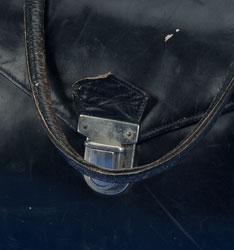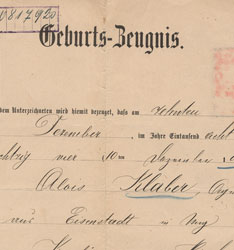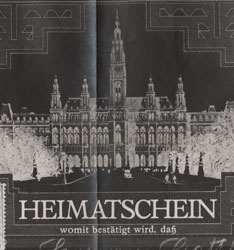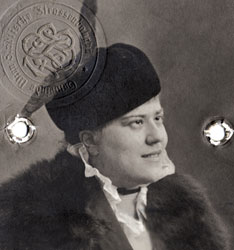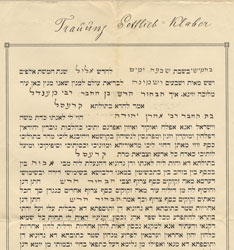
A Family History, 1918–1938
Camilla kept her family’s official papers, including her Heimatschein—citizenship record—inside her purse to document their lives in Austria.
Camilla Klaber, one of Vienna’s 200,000 Jews, married Hermann Gottlieb in 1918 at the age of thirty-four. She was an accomplished seamstress and pianist and Hermann, a chemical engineer, held a prestigious civil service post as head of the Research Institute of the Austrian Mint. The Gottliebs enjoyed a secure and cultured home life in pre–World War II Vienna. Their only child Lony was born in 1919.
Although respected Austrians, their citizenship was disregarded and their contributions dismissed when the Germans took control of the country in 1938. Eighteen-year-old Lony and Camilla’s brother Felix and his wife escaped to America; the war left Camilla and Hermann stranded in Vienna.
Purse, about 1930
Carried by Camilla to Theresienstadt, this purse contained records of her family’s identity, heritage, and prewar life. Without these she was a nonentity. The purse traveled with Camilla to America. After her death, her family found it at the back of her closet with all the papers intact.
Geburts-Zeugnis, 1884
Camilla’s birth certificate was one of the most important papers in her purse. With an official stamp, it documented her place of birth as Vienna, Austria, in December 1884. In April 1903 the Registration Bureau of the Vienna Jewish Cultural Community reconfirmed the date.
Heimatschein, 1939
Camilla’s citizenship document, like her birth and marriage forms, provided tangible evidence of her past self. The Heimatschein, “certificate of origin,” signified an inherited right of citizenship granted to the child through the father. When married, women took their husband’s citizenship.
Photo identification, about 1930
This photograph from Camilla’s 1930s identity card portrayed a confident and prosperous woman. In several years it would be worthless, and her life in disarray.
Ketubah, 1918
Camilla safely kept her traditional Jewish wedding contract, the ketubah. It signified her protection and rights in her marriage to Hermann. Written in Aramaic, the early language of the Jews, it noted the date of the wedding (1918) based on the Hebrew calendar, the bride and groom, and the names of their fathers and two witnesses.
Stole and suit, about 1930
Camilla Gottlieb wore this fashionable stole and suit in her prewar identification card image. In one of her first letters to Lony after her liberation, Camilla wrote: “The people who took care of some of our things did not count on us returning alive.” They may have kept these clothes, which she later brought to America.

